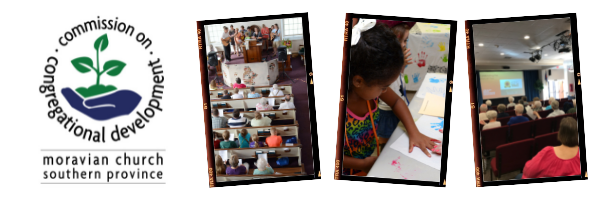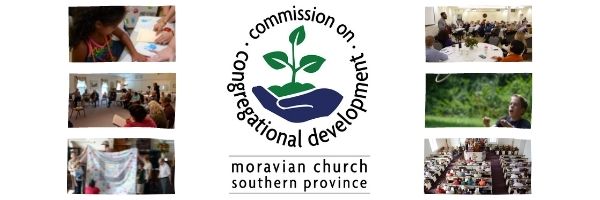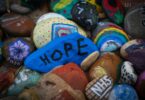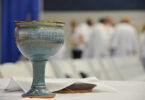
BY WILLIAM NEEDS |
Note: This is part of a monthly blog series, “Coffee with Moravian Ancestors.” Bill sits down with important figures in the Moravian church to have a cup of (Moravian) coffee, asking questions about his or her life and how they have impacted the church! Look for Bill’s other blog posts here. To accompany his blog posts, he has drawn the images from his trip to Europe on the Roots of the Moravian Church Tour. For more art, visit Bill’s website at BillNeeds.com.
__________________________
August Spangenberg earned the nickname “Brother Joseph,” possibly joking but just as likely serious because his temperament reminded Zinzendorf of Joseph from the Old Testament who tended “to take care of his brothers.” When Spangenberg met the Unitas Fratrum in the 1740s an identity crisis was brewing. Under Zinzendorf’s direction, the Moravian Brethren had become a popular “society” which influenced Europe’s Christian population through locally established congregations. Its mission was not to proselytize other Christians.
Moravian Brethren were also beginning to spread it’s message about Jesus to foreign populations in the “new world.”
The 1700s saw the protestant reformation grow beyond the limits established by the Augsburg Confession. The “Age of Reason” encouraged debate. Debate awakened alternate theologies from which protestant conscience changed and churches emerged reflecting features of their culture. Churches became more “tribal” in their identity.
Zinzendorf was the beloved leader of the Moravians, but his impulsive tendencies would limit their potential. Spangenberg provided balance.
Coffee with August Spangenberg (1704 – 1792)
Q. Brother Joseph, would you please give some background of how you developed a relationship with Count Zinzendorf and the Moravians?
A. I was blessed with a long life, so sit back, there’s a lot to tell….
I met Zinzendorf when training teachers in Jena in 1729. I had recently graduated from Jena University and, although ordained by the Lutheran Church, I felt drawn to social services. I had joined a union of religious students teaching poor children when Count Zinzendorf passed through Jena to show his support as an aristocrat. He invited me to visit Herrnhut.
My visit to Herrnhut in 1730 introduced me to this charismatic leader who professed unity of all Christians; and to refugees from Moravia who seemed devoted to holy living, ceaseless praying, cheerful giving, and practical discipleship.
Stirred by what I witnessed, I returned to Jena committed to inserting Christian ideals into our school. Authorities rebuked us, however, claiming we were too revolutionary. They called our school a “Zinzendorfian institution” and shut it down. Obviously, my efforts in Jena were unwelcome. I decided my talents and training would fit better in Herrnhut. When Zinzendorf requested my help to secure his ordination in the Lutheran Church, I accepted. This was in 1733.
Q. It is understood that those who arrived in Herrnhut came as religious refugees seeking freedom to worship. Your arrival was different. Was there nowhere else for you to go?
A. I’m certain I could have found other job opportunities, but the prospect of working for Zinzendorf was appealing. He didn’t speak in lofty poetic language but as a thinking man whose words originated in the heart. He carried himself as a nobleman but was confident in his Christian calling. He prepared moving sermons and hymns.
He was only 4 years older than me and, although his passion seemed to disconnect occasionally from the reality of the moment, I was charmed by his unbridled idealism. He was surrounded by highly qualified men from Moravia; “brethren” with whom he shared leadership of the commune. There were also capable women; Countess Erdmuth Dorothea was his wife and the cool operational brain behind the overheated heart of the Count; and young Anna Nitschmann who convincingly managed the Women’s “Choir”, served as “Eldress” to represent all women of Herrnhut on the male-dominated Board of Elders, and she served as governess to Benigna, Zinzendorf’s firstborn child.
As I examined the community I was joining, I became aware Count Zinzendorf was observing me, assessing my capacity to serve him as “second in command.”
Q. Wait a minute… Since 1728, Zinzendorf had already spread Moravian influence across Europe and by 1733 had begun missions to the Danish colonies in the Caribbean and North Atlantic, what did he want you to do that wasn’t already being done?
A. Remember, Zinzendorf yearned to become a Lutheran clergyman. He called me to help him fulfill that dream. Had he succeeded, the Moravian Church would likely have merged into the Evangelical Lutheran Church. However, Zinzendorf’s writings, hymns, and his noble experiment with piety in Herrnhut were viewed as revolutionary; a threat to the State Church of Germany; a misperception I had experienced in Jena albeit on a larger scale.
Saxony’s political forces were prepared to not only block Zinzendorf’s ordination but also to remove him from their midst. They had already succeeded in prohibiting any additional Moravian arrivals. They denounced Zinzendorf as a religious freak who promoted opinions contrary to the teaching of the Lutheran Church.
When accused of trying to found a new sect, he argued that Moravians sheltered in Herrnhut were descendants of the Bohemian Brethren, the ancient Unitas Fratrum that had been recognized by Luther, Calvin, and others. Their doctrine was as orthodox as Lutheranism and their discipline was superior. But, his argument wasn’t enough. When banishment became eminent, Zinzendorf asked me to help administer Moravian outreach while he examined his options in exile.
Q. Interesting! What specifically did Count Zinzendorf have in mind for you?
A. Zinzendorf had a burning desire to take the message of Christ to foreign populations ignorant of the Bible. He also had wealth and “connections.” To accomplish this, he needed to use his networks with his influential acquaintances of Germany, Norway, Holland, and England.
His proposal was simple: to send Moravian missionaries from Herrnhut into colonies selected by his allies. His proposal was brilliant in that every Moravian mission would be entirely independent and free-standing, not dependent on state affiliation or corporate subsidies. After prayerful review, Zinzendorf asked me to work as his ambassador to help nurture these contacts into workable contracts. He was 34 years old and “knew people” he insisted I should get to know.
Q. This sounds like a fascinating “job assignment!” Can you describe some of your activities?
A. Simply stated, I was 30 years old when I became a world traveler… not an easy assignment when you consider that traveling then required sturdy boots, a horse or horse-drawn carriage, a river barge, or a sailing ship. All transportation depended upon tides and weather. Travel was very risky!
Maintaining communication was also a challenge. Letters became important reports. The time required to carry reports across the miles increased the possibility for errors or misunderstanding.
Of course, there was also international political intrigue. For example, I used Moravian missions on Denmark’s Caribbean Islands and Greenland as models of success when negotiating with Trustees of Georgia and the Society of Suriname (in Amsterdam) to establish a Moravian mission in South America.
Following success with the Dutch, I began negotiations in London in 1735 for the first “Protestant mission” to the “Indians” of America’s mainland. Establishing a foothold in Savannah would not come easily. Coordination was required between King George, the Archbishop of Canterbury, and General Oglethorpe, the newly appointed governor of the Colony of Georgia The deal was sealed and, in 1736, I led the first group of Moravian missionaries into Savannah.
That same year, Zinzendorf was banished from Saxony.
Q. The Moravian leader banished from his homeland certainly complicates an already complex endeavor. How did that go?
A. Refusing to be broken by exile, Zinzendorf outwardly embraced it as a gift from God. He found refuge in a dilapidated castle in the Western part of Germany, not far from Frankfurt. Marienborne became an operational center for him and his followers which he named his “Pilgrim Congregation.”
Zinzendorf began planning another community similar to Herrnhut in structure and spirit. That village would be called Herrnhaag (“Lord’s Grove”). He also launched a schedule of visits throughout Europe offering his support to Moravians in diaspora. He was frequently accompanied by Anna Nitschmann or others from his “Pilgrim Congregation.” It seems exile enhanced his determination.
On the other hand, Zinzendorf was privately troubled over his personal banishment from Saxony. Fearing banishment might extend to Brethren in Herrnhut, I was ordered to assess whether Savannah and Philadelphia might serve as an overseas base from which to operate unhindered, “just in case.” After all, other “denominations” had chosen America to escape Europe’s religious persecution.
Nevertheless, Zinzendorf spared no expense building Herrnhaag into an impressive array of orderly buildings. If Herrnhaag was intended to be a reflection of spartan Herrnhut, it failed in its opulence. Excesses seeped into the operational reasoning behind the community. I’ll explain this later.
On a positive note, Zinzendorf decided this time in exile provided a fitting opportunity to visit the foreign missions. Why not America?
Q. You were in America when Zinzendorf formed these plans for a tour of America. What were you doing?
A. I had started the first successful Moravian mission post in North America. In 1737 I left Savannah for Philadelphia, assigned to assess the practicality of establishing a Moravian presence in this section of America, I was delighted with what I found.
German settlers who migrated to the fertile wilderness around Philadelphia were starting productive farms. I spent two years in their midst, assisting in the physical labor of farming and counseling when needed according to their spiritual needs. During those years I saw the short-term effect George Whitefield’s “crusades” had upon European settlers. Obviously, with few ordained clergies available to German farmers, ongoing spiritual needs were unmet. I sent Zinzendorf my observations.
I witnessed harsh land-grabbing techniques used by Europeans to obtain land from the natives. “Ownership” of land was a concept difficult for “Indians” to grasp. They considered land, water, and air as gifts from God. That man could buy and sell these gifts was a novel concept to the native, bordering on sacrilege. I concluded it would be difficult to convince them that European Christians represented a forgiving God, let alone an equitable God. Nevertheless, the loose confederation of Native American tribes would prove no match to militant European settlers.
While in Pennsylvania, I received distressing letters from Peter Boehler in Savannah expressing fear for keeping the Savannah mission alive let alone successful. Brother Peter informed me that “the good children had lost sight of their plan.” I made a mental note that success in the mission field would require more than just good intentions, hard work, and prayer. The next community would require a plan and a patriarch.
Q. It sounds as if Zinzendorf had the “time” to make an extended trip to America. Was he motivated by anything else?
A. Yes, early Moravian missionaries were sent to foreign countries in 1732 without the protection of governments or armies (compared to protection offered by Roman Catholic missionaries). During the following years, Zinzendorf was publicly criticized for sending young missionaries off to die. At times he was accused of being a cult leader. So, Zinzendorf decided banishment provided him an opportunity to defend his ambitions. In 1738, he left Europe bound for the Caribbean to demonstrate his personal support. Uncertain that he would return, he left his will with his wife in Herrnhut and assigned oversight of Herrnhaag to his son, Christian Renatus.
Zinzendorf made news in Pennsylvania when I read reports he had safely arrived in St. Thomas in January of 1739 only to find his missionaries in prison. Incensed by what he considered fabricated charges, he demanded their release. He rebuked authorities for jeopardizing the mission. His intercession was so forceful that it not only freed the Moravian missionaries but also brought legal recognition to over 800 slaves who had claimed conversion to Christ.
Although Zinzendorf’s visit was timely and effective, it was cut short when he contracted malaria. Instead of continuing on to Savannah, he returned to Europe to convalesce. His tour to American colonies would have to wait.
During his treatment, Zinzendorf called me back to Europe in 1739. The impending failure of the Savannah mission caused us both to rethink effective strategies to reach the native populations. I proposed establishing small settlement “preaching stations” with schools for boys, missions to “Indians,” and a communal center to provide social organization and an economic base. I had in my mind the model of simple and practical Herrnhut rather than the more ostentatious Herrnhaag.
We also brainstormed how to serve German farmers in Pennsylvania. Due to the hardened personality of frontiersmen and the suspicious nature of the “Indian,” we agreed an unorthodox approach might be found in the presence of a woman. Anna Nitschmann seemed a logical choice. In the winter of 1739, Anna accompanied her father David when sent to survey property purchased on the Lehigh River and to make plans for building.
When Zinzendorf recovered his health in 1741 he left again for Pennsylvania, this time accompanied by his 16-year-old daughter, Benigna. We agreed I should remain in London during his absence. Contacts with the Archbishop of Canterbury were critical to influence Moravian growth in England, I could also develop foreign missions in English, Danish, and Dutch colonies through their diplomatic corps in London.
I remained in England until my 1734 consecration as Bishop of the Moravian Church when I was sent back to Bethlehem.
Q. While you remained in England, Count Zinzendorf toured Britain’s colonies? Was that safe? Wasn’t it unusual that a nobleman from Europe should plan to conduct such a visit to the backwoods of developing colonies?
A. Count Zinzendorf’s arrival in Philadelphia did cause a stir. He was one of only a few noblemen from Europe to set foot in the Americas in the 1700s. Of course, he conducted business with government leaders such as Benjamin Franklin. He even assumed the role of pastor for a struggling Lutheran church for a short time, but he had much more on his agenda.
Venturing into the wilderness, he met the Six Leaders of the Iroquois Confederacy in the mountains of Pennsylvania, along New York’s Hudson River, and throughout the Wyoming Valley along the Susquehanna River. Accompanied by Anna Nitschmann, he negotiated agreements for free movement of Moravian missionaries through the region. On Christmas Eve, he formalized the naming of Bethlehem as the center from which Moravians would launch their spiritual venture into the wilderness.
He convened conferences (Synods) with numerous German leaders, attempting to direct religious attention away from denominational affiliations and instead to unite their focus upon the spirit of Christ in their midst, a “United Nations” of churches if you will. His personal theology of the oneness of all believers played into these initiatives, despite the ultimate failure. He met Herrnhut Brethren who had recently arrived in Bethlehem. While David Nitschmann managed to develop the community aided by his 26-year-old daughter, Anna.
It was not planned that choirs be established in Bethlehem for single women, but Anna’s charm and assertive leadership was eagerly accepted by young women, both native and German. Noting her influence, Zinzendorf allowed choirs to dominate early Bethlehem in the same manner as in Herrnhut. Her confidence inspired frontiersmen as well as wives and daughters. Bethlehem’s choirs became a familiar institution when welcoming future emigrants from Herrnhut, those who bore the name, “Sea Congregation.”
The accomplishments of Anna did not end with establishing choirs. Moravian Elders planned a boarding school for women should be established in the safety of Philadelphia. Anna and Benigna insisted this school be established in Bethlehem. Their foresight resulted in establishing a women’s college (later Moravian College and Theological Seminary) as the 6th school for higher education in America.
Q. You were in England while Zinzendorf toured America. What occurred in Europe during this time?
A. Sadly, Zinzendorf’s absence from Europe invited the emergence of two conflicting policies for the future of the Moravian Brethren. The group of 12 Trustees assigned to oversee the Moravian effort in Europe developed a major split over their assignment.
One segment of Trustees adhered to the conservative path of Moravian diaspora societies as established in recent years. Another segment pushed the Unitas Fratrum in a direction to establish an independent denomination. Hearing this news Zinzendorf rushed back to Europe in 1743 and was disturbed by what greeted him. The Trustees were indeed directing the Moravians toward denominational separation from the Lutheran or any other church. This action was contrary to anything the Count had proposed. He was outraged!
Now I ask myself “what were they thinking?” I knew Zinzendorf was committed to keeping the Moravian Brethren and societies independent from denominational aspiration. He had spent vast sums of money and incurred debt to grow this dream. “Should I have been more sensitive and involved to prevent such action?”
Q. This wasn’t your fault, was it? The committee of 12 Trustees assigned to oversee the Moravian effort in Europe was responsible, is this not right?
A. I guess I just didn’t want to get involved in the affairs between Zinzendorf and descendants of the ancient Unitas Fratrum. That was none of my business. Shortly after Zinzendorf returned, I have consecrated a Bishop then sent back to America to implement economic plans suited for the long-term development of Bethlehem. Meanwhile, Zinzendorf sorted out the mess that had occurred in his absence.
As expected, Zinzendorf immediately went about undoing all the mischief that had been done. I’m told the entire group of 12 Trustees were contrite to the will of their leader. They relinquished nearly all control to Zinzendorf setting the overall management into an autocratic direction. This episode would have major consequences for the future of the Unitas Fratrum.
Q. This doesn’t sound good. The history of the Unitas Fratrum has been filled with examples of equally shared responsibility whenever plans are made and action taken. What happened next?
A. An answer to that question isn’t completely clear. There is evidence that Zinzendorf began to exhibit more manic behavior after 1743, but this behavior went unchecked by Elders of the church. He obsessed over publishing controversial tracts. His sermons became more sensational to the extreme. Even words in his hymns reflected his puzzling nature. Rumors swirled that established spiritual practices in Herrnhaag changed into bizarre mystical ceremonies. It was claimed that Zinzendorf’s own “blood and wound” theology was distorted to justify sensual interpretation and experimentation. The reputation of Moravian Brethren, previously untarnished, began to morph into a radical cult.
Numerous Synods were called by Zinzendorf during the 1740s to deal with issues under his control, but he seemed to ignore the sound advice from Elders. Financial records were questioned. Over the years, the books of the Unitas Fratrum had been mixed with the personal finances of Zinzendorf. Large debts incurred with leaders of other countries exacerbated the appearance of wrongdoing. Answers to difficult questions are not easily found because historical documents representing the years from 1743 to 1750, now known as “The Sifting Time,” were destroyed or hidden, possibly to protect the reputation of the Moravians.
Q. While you were in America, it’s fair to assume you didn’t know that much about the excesses during the Sifting Time?
A. I’d prefer to not answer that question, I was not there and the reports that I received were unbelievable. I don’t want to contribute to rumors about the Count.
Nevertheless, letters from Europe indicating Zinzendorf’s personality had changed. He became more reclusive and his decisions more impulsive. He traveled extensively seeking to reinforce his control. He seemed unaware of the damage wrought by explosive words chosen when speaking or writing.
Let me give you the facts as I understand them:
- From 1749- 1755: Zinzendorf lived in London but traveled extensively.
- 1749: Authorities in Saxony rescinded his banishment allowing his return.
- 1749: He recalled his son from Herrnhaag and rebuked him for misdirections.
- 1750: Residents began abandoning Herrnhaag, many to join the “Sea Congregation” bound for Bethlehem.
- 1752: Zinzendorf’s son Christian Renatus died of Tuberculosis.
- In 1752: A broken Count Zinzendorf finally acknowledged his financial straits. Financial embarrassment would have a positive effect by forcing a return to sober scriptural thought and ritual and curb Zinzendorf’s autocratic powers.
- 1755: Zinzendorf returned to Herrnhut to thus reestablish its importance.
- 1756: Erdmuth Dorothea died and Zinzendorf retreated into seclusion again.
- 1757: Zinzendorf was encouraged to marry Anna Nitschmann.
- May 1760: Zinzendorf died leaving an obvious leadership vacuum.
- 1762: I was called back to Herrnhut to repair the image and consolidate the theology upon which the Moravian Church was based.
Q. During these years, what were you doing in America?
A. Upon my return to Bethlehem in 1744, I began 5 years devoted to establishing what I consider elements essential for the survival of Moravian missions. The initial development of Bethlehem was assigned to David Nitschmann. The European economy then was based upon the exchange of cash (i.e. purchasing goods and services with cash). It’s no surprise that a cash economy was common in developing cities of America. In my mind, however, this policy was a mistake for frontier villages. I had shared my thoughts with Zinzendorf earlier and, with my return to the village of Bethlehem in 1743 as Bishop, I carried authority to take radical action.
The purpose for this settlement on the banks of the Lehigh was for the work of the Lord. Because of the urgency for this cause, to maintain health and motivation, the interests of family and individual prosperity must become secondary to the work of the church. Therefore, my plan was to manipulate the economy of Bethlehem to make it a community of labor rather than a community of property. No private enterprise existed. No private property existed. Instead, all forms of business and production belonged to the church, as did all real estate. Labor was assigned based upon individual talents and the needs of the community. I called this plan simply “The Economy,” supervised by Elders of the local church, who reported to me.
When The Economy became firmly established in Bethlehem, men and women regarded work for the Lord as of far greater importance than work for themselves. Despite hardships and self-denial, The Economy system yielded a deep sense of happiness and contentment across all of Bethlehem and Nazareth. Within 3 years at least 32 industries had been developed and many productive farms. The Economy supported 50 evangelists, 15 schools, and traveling expenses to the West Indies and Surinam missions. Indeed, when Bethlehem residents learned of the financial woes encountered by Moravian brethren in Europe, Bethlehem was financially able to return a portion of the capital investment on its own development. Bethlehem became a successful base, capable to provide service and supplies for “Indian” missions on the interior, as well as social and spiritual support when needed.
Domineering measures? Of course. For the time being, the urgency of establishing successful missions required a clear plan, domineering leadership, and personnel committed to the work of the Lord! Over time, that priority was destined to change and the continuance of communal life and choirs would diminish. I was called back to Europe in 1749 to spend a couple of years dealing with the issues of fiscal integrity, public relations, and “reality” intercession for Zinzendorf.
My return to America in 1752 and the successful implementation of The Economy in Bethlehem opened the opportunity for me to explore and expand Moravian settlements into North Carolina. Of course, The Economy would be the operational model for each new Moravian commune established. That model would remain in effect until each community became self-sustaining or until relations with nearby settlements supported an economy based upon cash transactions.
I remained in America until 1762. Following the 1760 death of Count Zinzendorf, my organizational and leadership skills were required in Europe. My return to Herrnhut was met with tears of joy.
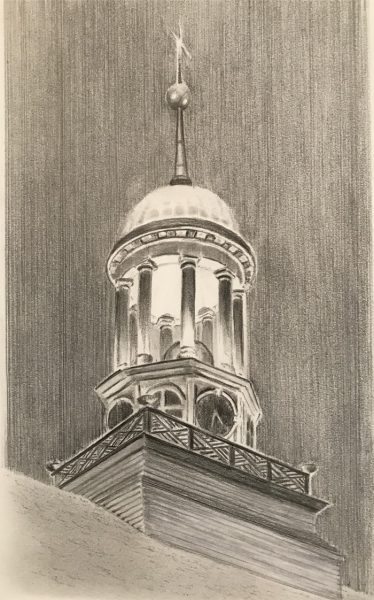
Belfry of Central Moravian Church in Bethlehem, Pennsylvania | Drawn by Bill Needs
In the 1720s, descendants of the Bohemian Brethren came out of hiding, migrated to Germany then, under the generous leadership of Count Zinzendorf, dared to extend their influence into the world. Their effort had two-prongs: a message about love and redemption found in Jesus Christ for the non-believer or heathen; and an example of pious living for every Christian seeking to deepen his personal relationship with Jesus.
The 1740s became a season of many changes through storms. While Zinzendorf’s style would spark storms, Spangenberg became a man for all seasons. In the 1770s, his sensitive style, diplomatic abilities, and thoughtful words calmed the storms, removed most doubt, and merged the best qualities of the Age of Reason and the Great Awakening.
No matter what name was given, Unitas Fratrum, Moravian Brethren, Moravian Societies, Brudergemein, Pilgrim Congregation, Sea Congregation; all would become known as the Moravian Church through the reassuring influence of Bishop Spangenberg, also known as “Brother Joseph.”
Our coffee conversation continues on February 20 with Brother Georg Schmidt, Moravian missionary to South Africa’s Hottentots.
__________________________
About the Author

Photo courtesy of Bill Needs.
Raised in the Moravian Church in Dover Ohio, Bill graduated from Moravian College in 1962. A drop-out of Moravian Theological Seminary, Bill now lives with his wife, Sara in Marietta, Georgia. Bill’s career served disabled individuals and employers in providing realistic vocational choices as a Vocational Rehabilitation Counselor. After retirement in 2004, Bill discovered he had a previously unknown artistic talent for drawing. Now, when Bill and Sara travel, he supplements his photography record with art inspired by the scenes and experiences. For more art, visit Bill’s website at BillNeeds.com. For discussion about art or blog content, email [email protected].
Requests for republishing, click here.
Want to volunteer to write for us? Click here.

